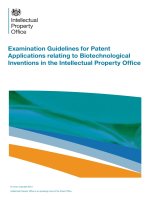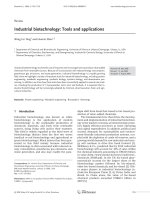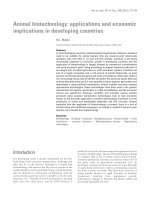mpls-enabled applications
Bạn đang xem bản rút gọn của tài liệu. Xem và tải ngay bản đầy đủ của tài liệu tại đây (10.18 MB, 435 trang )
MPLS-Enabled Applications
Emerging Developments and
New Technologies
Ina Minei
Juniper Networks
Julian Lucek
Juniper Networks
ffirs.fm Page v Wednesday, September 7, 2005 8:02 PM
ffirs.fm Page iv Wednesday, September 7, 2005 8:02 PM
‘As MPLS has grown in popularity, most books on the subject have concentrated
on explaining the basics, or illustrating how the core function can be successfully
deployed. Minei and Lucek, however, have taken the subject on to the next level.
They explain the new and significant developments in MPLS showing how the
technology has come of age and how it will be used to build advanced services in
complex, interconnected networks. This book provides an important tutorial on
the recent advances in MPLS, and brings together many of the threads from the
IETF to provide a comprehensive overview of the next generation of MPLS
networking.’
Adrian Farrel, Old Dog Consulting Ltd., IETF CCAMP and PCE working groups
co-chair
‘While MPLS is in itself simple, its apparent complexity lies in the proliferation of
applications, which shows no signs of ceasing. To make things worse, catching up
involves reading a large number of documents written by various authors at various
times in various styles. Here at last is a single, all-encompassing resource where the
myriad applications sharpen into a comprehensible text that first explains the whys
and whats of each application before going on to the technical detail of the hows.’
Kireeti Kompella, Juniper Fellow, Juniper Networks.
‘MPLS-Enabled Applications thoroughly covers the MPLS base technology and
applications on MPLS-enabled IP networks. It guides you to a comprehensive
understanding of standards, problems, and solutions in networking with MPLS.
Before it had been necessary to go through material from many different sources,
here we have everything in one place. All the MPLS protocols are covered, as are
the applications of these protocols. This should be the textbook for MPLS
courses, both for training of experienced networking professionals and for
universities.’
Loa Andersson, Acreo AB, IAB-member and IETF MPLS working group co-chair
‘This is the MPLS text that the industry has been waiting for. On one hand, the text
presents MPLS technology clearly enough that the reader can absorb its content in a
few easy sittings. On the other hand, the text provides a sufficiently in depth
treatment that even an MPLS expert can learn from it. The authors offer a clear and
complete description of MPLS, its inner workings and its applications, in a manner
that could only be achieved by persons who have been significant contributors to
the MPLS development effort. Every network operator who has deployed or is
considering the deployment of MPLS technology should read this book. It is appro-
priate reading for everyone from the CTO to the tier 1 NOC engineer.’
Ron Bonica, Engineer, Juniper Networks, IETF L3 VPN working group co-chair
‘My first impression after reading a few selected chapters of MPLS-Enabled
Applications has been very good. It attempts to describe a number of modern tech-
niques to address today’s customer requirements. It should be a good reference
ffirs.fm Page i Wednesday, September 7, 2005 8:02 PM
for network operators who face significant challenges to keep up to date with
latest developments of new and emerging networking services.’
Robert Raszuk, Technical Leader, Routing Protocols Deployment and Architecture, Cisco
Systems
‘MPLS-Enabled Applications provides an excellent review of the fundamentals and
key applications of the MPLS suite of protocols. Its balanced mix of both the
technical and business motivations for using these applications make it a must-
read for anyone involved in enterprise or service-provider networks.’
Dave Cooper, Sr. Manager IP Engineering, Global Crossing, Ltd.
‘This is a highly recommended book for those wanting to update themselves with
the latest MPLS developments, or those just wanting to learn this technology
thoroughly. In addition to the impressive technology coverage and depth, the
book is also a delightful reading!’
Lei Wang, IP Network Architect, Telenor
‘MPLS-Enabled Applications is an excellent read for network engineers involved in
the design of MPLS networks and services. It can serve as an introduction to
MPLS networking or as a reference book for the advanced engineer. It discusses
practical issues that must be considered in the design of MPLS networks and
services, including MPLS-TE, MPLS-IPVPNs and MPLS L2 VPNs. It also
discusses current topics that are still evolving in the industry such as inter-
AS/area MPLS-TE, point-to-multipoint LSPs and IPVPN multicast, providing a
good overview of the issues being addressed and the current industry direction.’
Nabil N. Bitar, Principal member of Technical Staff and lead network architect, Verizon
‘MPLS Enabled Applications presents the current state of the art in the specification,
development, and application of MPLS and its related technologies. I believe, the
readers will find the book to be a very valuable resource.’
Bijan Jabbari, PhD, Founder of Isocore, and Professor of Electrical Engineering, George
Mason University
‘Too few people have the scarce skill for clearly explaining things. Fewer still
have a clear understanding of the MPLS protocol and architectures. Minei and
Lucek seem to have them both.’
Dr. Eyal Felstaine, senior staff member, Ben Gurion University, Israel
‘This book provides an excellent overview of MPLS mechanisms and applications.
It allows understanding what we can do today and what we will be able to do
tomorrow with MPLS, as it covers not only stable and deployed technologies
such as MPLS Fast Reroute, L3 VPNs, L2 VPN, but also new technologies under
development within the IETF, such as IP/LDP Fast Reroute, inter-domain Traffic
Engineering and Point-To-Multipoint MPLS. Hence this book will be highly
useful for network designers, operators, students as well as anyone interested
with the MPLS architecture.’
Jean-Louis Le Roux, Senior MPLS architect, France Telecom
ffirs.fm Page ii Wednesday, September 7, 2005 8:02 PM
MPLS-Enabled Applications
ffirs.fm Page iii Wednesday, September 7, 2005 8:02 PM
ffirs.fm Page iv Wednesday, September 7, 2005 8:02 PM
MPLS-Enabled Applications
Emerging Developments and
New Technologies
Ina Minei
Juniper Networks
Julian Lucek
Juniper Networks
ffirs.fm Page v Wednesday, September 7, 2005 8:02 PM
Copyright © 2005 John Wiley & Sons Ltd, The Atrium, Southern Gate, Chichester,
West Sussex PO19 8SQ, England
Telephone (+44) 1243 779777
Email (for orders and customer service enquiries):
Visit our Home Page on www.wiley.com
All Rights Reserved. No part of this publication may be reproduced, stored in a retrieval
system or transmitted in any form or by any means, electronic, mechanical, photocopying,
recording, scanning or otherwise, except under the terms of the Copyright, Designs and
Patents Act 1988 or under the terms of a licence issued by the Copyright Licensing Agency
Ltd, 90 Tottenham Court Road, London W1T 4LP, UK, without the permission in writing of
the Publisher. Requests to the Publisher should be addressed to the Permissions Department,
John Wiley & Sons Ltd, The Atrium, Southern Gate, Chichester, West Sussex PO19 8SQ,
England, or emailed to , or faxed to (+44) 1243 770571.
This publication is designed to provide accurate and authoritative information in regard
to the subject matter covered. It is sold on the understanding that the Publisher is not engaged
in rendering professional services. If professional advice or other expert assistance is
required, the services of a competent professional should be sought.
Other Wiley Editorial Offices
John Wiley & Sons Inc., 111 River Street, Hoboken, NJ 07030, USA
Jossey-Bass, 989 Market Street, San Francisco, CA 94103-1741, USA
Wiley-VCH Verlag GmbH, Boschstr. 12, D-69469 Weinheim, Germany
John Wiley & Sons Australia Ltd, 42 McDougall Street, Milton, Queensland 4064, Australia
John Wiley & Sons (Asia) Pte Ltd, 2 Clementi Loop #02-01, Jin Xing Distripark,
Singapore 129809
John Wiley & Sons Canada Ltd, 22 Worcester Road, Etobicoke, Ontario, Canada M9W 1L1
Library of Congress Cataloging in Publication Data
Minei, Ina.
MPLS-enabled applications : emerging developments and new technologies / Ina Minei,
Julian Lucek.
p. cm.
Includes bibliographical references.
ISBN 0-470-01453-9 (alk. paper)
1. MPLS standard. 2. Extranets (Computer networks) I. Lucek, Julian. II. Title.
TK5105.573.M56 2005
621.382′16—dc22
2005022611
British Library Cataloguing in Publication Data
A catalogue record for this book is available from the British Library
ISBN 0-470-01453-9
Typeset in 11/13pt Palatino by Integra Software Services Pvt. Ltd, Pondicherry, India
Printed and bound in Great Britain by Antony Rowe Ltd, Chippenham, Wiltshire
This book is printed on acid-free paper responsibly manufactured from sustainable forestry
in which at least two trees are planted for each one used for paper production.
ffirs.fm Page vi Wednesday, September 7, 2005 8:02 PM
MPLS-Enabled Applications: Emerging Developments and New Technologies Ina Minei and Julian Lucek
© 2005 John Wiley & Sons, Ltd
Contents
About the Authors xiii
Foreword xv
Preface xix
Acknowledgements xxiii
Part One 1
1 Foundations 3
1.1 Historical perspective 3
1.2 Current trends 5
1.3 MPLS mechanisms 6
1.3.1 Forwarding plane mechanisms 8
1.3.2 Control plane mechanisms 12
1.4 Conclusion 34
1.5 References 34
1.6 Further reading 36
2 Traffic Engineering with MPLS (MPLS-TE) 37
2.1 Introduction 37
2.2 The business drivers 38
2.3 Application scenarios 39
2.4 Setting up traffic-engineered paths using MPLS-TE 42
2.4.1 LSP priorities and preemption 42
2.4.2 Information distribution – IGP extensions 43
ftoc.fm Page vii Saturday, September 3, 2005 7:54 PM
viii CONTENTS
2.4.3 Path calculation – CSPF 45
2.4.4 Path setup – RSVP extensions and admission control 48
2.5 Using the traffic-engineered paths 51
2.6 Deployment considerations 55
2.6.1 Scalability 55
2.6.2 Reservation granularity 57
2.6.3 Routing challenges 58
2.7 Using traffic engineering to achieve resource optimization 59
2.7.1 Autobandwidth – dealing with unknown bandwidth
requirements 60
2.7.2 Sharing links between RSVP and other traffic – dealing
with unknown bandwidth availability 60
2.7.3 Other methods for optimization of transmission resources
in MPLS networks 62
2.8 Offline path computation 63
2.9 Conclusion 66
2.10 References 66
2.11 Further reading 67
3 Protection and Restoration in MPLS Networks 69
3.1 Introduction 69
3.2 The business drivers 70
3.3 Failure detection 71
3.4 End-to-end protection 73
3.5 Local protection using fast reroute 75
3.6 Link protection 78
3.6.1 What happens before the failure 79
3.6.2 What happens after the failure 84
3.7 Node protection 86
3.8 Additional constraints for the computation of the protection path 88
3.8.1 Fate sharing 88
3.8.2 Bandwidth protection 90
3.8.3 Bandwidth protection and DiffServ 93
3.9 Interaction of end-to-end protection and fast reroute 94
3.10 Deployment considerations for local protection
mechanisms 95
3.10.1 Scalability considerations 95
3.10.2 Evaluating a local protection implementation 98
3.10.3 The cost of bandwidth protection 101
3.11 IP and LDP FRR 103
3.12 Conclusion 108
3.13 References 108
3.14 Further reading 109
4 MPLS DiffServ-TE 111
4.1 Introduction 111
4.2 The business drivers 112
ftoc.fm Page viii Saturday, September 3, 2005 7:54 PM
CONTENTS ix
4.3 Application scenarios 113
4.3.1 Limiting the proportion of traffic from a particular
class on a link 113
4.3.2 Maintaining relative proportions of traffic on links 115
4.3.3 Providing guaranteed bandwidth services 116
4.4 The DiffServ-TE solution 116
4.4.1 Class types 116
4.4.2 Path computation 117
4.4.3 Path signaling 120
4.4.4 Bandwidth constraint models 120
4.4.5 Overbooking 126
4.4.6 The DiffServ in DiffServ-TE 128
4.4.7 Protection 129
4.4.8 Tools for keeping traffic within its
reservation limits 130
4.4.9 Deploying the DiffServ-TE solution 132
4.5 Extending the DiffServ-TE solution with
multiclass LSPs 133
4.6 Conclusion 134
4.7 References 134
4.8 Further reading 135
5 Interdomain Traffic Engineering 137
5.1 Introduction 137
5.2 The business drivers 138
5.3 Setting up interdomain TE LSPs 139
5.3.1 Path setup 140
5.3.2 Path computation 145
5.3.3 Reoptimization 156
5.3.4 Protection and fast reroute 157
5.4 Interprovider challenges 160
5.5 Comparison of the LSP setup methods 161
5.6 Conclusion 162
5.7 References 162
5.8 Further reading 164
6 Point-to-Multipoint LSPs 165
6.1 Introduction 165
6.2 The business drivers 166
6.3 P2MP LSP mechanisms 168
6.3.1 Forwarding plane mechanisms 168
6.3.2 Control plane mechanisms 169
6.4 LAN procedures for P2MP LSPs 178
6.5 Coupling traffic into a P2MP LSP 181
6.5.1 Coupling Layer 2 traffic into a P2MP LSP 181
6.5.2 Coupling IP unicast traffic into a P2MP LSP 182
6.5.3 Coupling IP multicast traffic into a P2MP LSP 182
ftoc.fm Page ix Saturday, September 3, 2005 7:54 PM
x CONTENTS
6.6 MPLS fast reroute 185
6.7 Applications of point-to-multipoint LSPs 187
6.7.1 Application of P2MP TE to broadcast TV distribution 187
6.7.2 Application of P2MP LSPs to L3 VPN multicast 190
6.7.3 Application of P2MP LSPs to VPLS 191
6.8 Conclusion 192
6.9 References 192
Part Two 195
7 Foundations of Layer 3 BGP/MPLS Virtual Private Networks 197
7.1 Introduction 197
7.2 The business drivers 198
7.3 The overlay VPN model 199
7.4 The peer VPN model 201
7.5 Building the BGP/MPLS VPN solution 204
7.5.1 VPN routing and forwarding tables (VRFs) 204
7.5.2 Constrained route distribution 206
7.5.3 VPN-IPv4 addresses and the route distinguisher (RD) 207
7.5.4 The route target (RT) 209
7.5.5 The solution so far – what is missing? 215
7.5.6 VPN label 216
7.6 Benefits of the BGP/MPLS VPN solution 221
7.7 References 222
7.8 Further reading 222
8 Advanced Topics in Layer 3 BGP/MPLS Virtual Private Networks 223
8.1 Introduction 223
8.2 Routing between CE and PE 223
8.3 Route reflectors and VPNs 228
8.4 Scalability discussion 233
8.4.1 Potential scaling bottlenecks 233
8.4.2 The cost of growing the VPN network 236
8.5 Convergence times in a VPN network 241
8.5.1 Convergence time for a customer route change 242
8.5.2 Convergence time for a failure in the provider’s network 242
8.6 Security issues 243
8.7 QoS in a VPN scenario 245
8.8 Multicast in a VPN 247
8.8.1 The original multicast solution 248
8.8.2 Improving the existing multicast solution 253
8.9 Conclusion 258
8.10 References 258
8.11 Further reading 259
9 Hierarchical and Inter-AS VPNs 261
9.1 Introduction 261
9.2 Carriers’ carrier – service providers as VPN customers 262
ftoc.fm Page x Saturday, September 3, 2005 7:54 PM
CONTENTS xi
9.2.1 ISP as a VPN customer 264
9.2.2 VPN service provider as a VPN
customer – hierarchical VPN 269
9.3 Multi-AS backbones 273
9.3.1 Option A: VRF-to-VRF connections at the ASBR 274
9.3.2 Option B: EBGP redistribution of labeled VPN-IPv4 routes 275
9.3.3 Option C: multihop EBGP redistribution of labeled
VPN-IPv4 routes between the source and destination AS,
with EBGP redistribution of labeled IPv4 routes from one
AS to the neighboring AS 277
9.4 Interprovider QoS 278
9.5 Conclusion 280
9.6 References 280
9.7 Further reading 280
10 Layer 2 Transport over MPLS 283
10.1 Introduction 283
10.2 The business drivers 283
10.3 Comparison of Layer 2 VPNs and Layer 3 VPNs 286
10.4 Principles of Layer 2 transport over MPLS 287
10.5 Forwarding plane 289
10.5.1 ATM cell 291
10.5.2 ATM AAL5 292
10.5.3 Frame relay 292
10.5.4 Ethernet 293
10.6 Control plane operation 293
10.6.1 LDP signaling scheme 294
10.6.2 BGP-based signaling and autodiscovery scheme 295
10.6.3 Comparison of BGP and LDP approaches to Layer 2
transport over MPLS 300
10.7 Failure notification mechanisms 301
10.8 Layer 2 interworking 302
10.9 Circuit cross connect (CCC) 303
10.10 RSVP signaling for interdomain pseudowires 305
10.11 Other applications of Layer 2 transport 309
10.12 Conclusion 311
10.13 References 312
11 Virtual Private LAN Service 315
11.1 Introduction 315
11.2 The business drivers 315
11.3 VPLS mechanism overview 317
11.4 Forwarding plane mechanisms 321
11.4.1 Forwarding of unicast frames 322
11.4.2 Broadcast and multicast frames 325
11.5 Control plane mechanisms 326
11.5.1 LDP-based signaling 327
11.5.2 BGP signaling and autodiscovery 331
ftoc.fm Page xi Saturday, September 3, 2005 7:54 PM
xii CONTENTS
11.5.3 Comparison of LDP and BGP for VPLS control plane
implementation 339
11.5.4 Operational considerations 344
11.6 Conclusion 345
11.7 References 346
12 MPLS Management 347
12.1 Introduction 347
12.2 Management – why and what 347
12.3 Detecting and troubleshooting failures 349
12.3.1 Reporting and handling nonsilent failures 349
12.3.2 Detecting silent failures – MPLS OAM 351
12.3.3 Troubleshooting failures 362
12.4 Configuration errors 366
12.4.1 Preventing configuration errors 366
12.4.2 Detecting and reporting misconfigurations 369
12.5 Visibility 374
12.6 Conclusion 375
12.7 References 375
12.8 Further reading 376
13 Conclusions 379
13.1 Introduction 379
13.2 Network convergence 380
13.3 Interaction with client edge equipment 385
13.4 Interprovider capability 386
13.5 MPLS in the access network 387
13.6 MPLS in the enterprise 388
13.7 Final remarks 389
13.8 References 390
Acronyms 391
Index 401
ftoc.fm Page xii Saturday, September 3, 2005 7:54 PM
MPLS-Enabled Applications: Emerging Developments and New Technologies Ina Minei and Julian Lucek
© 2005 John Wiley & Sons, Ltd
About the Authors
Ina Minei has been a network protocols engineer at Juniper Networks
for the past five years working on next-generation network
technologies for core routers, where she focuses on MPLS protocols
and applications. She previously worked at Cisco for two years in
various software development projects for routers and switches.
Ms Minei is an active participant in industry fora and conferences
and has co-filed several patents in the area of IP and MPLS. She
holds a Master’s degree in computer science from the Technion,
Israel.
Julian Lucek joined Juniper Networks in 1999 and is currently the
Technical Leader for Junos for the Europe, Middle East and Africa
region, where he has been working with many service providers on
the design and evolution of their networks. He previously worked at
BT for several years, at first in the Photonics Research Department
and later in the data transport and routing area. During this time he
gained a PhD in ultrahigh-speed data transmission and processing.
He has a Master’s degree in Physics from Cambridge University and
holds Juniper Networks Certified Internet Expert (JNCIE) certification
number 21.
fbetw.fm Page xiii Saturday, September 3, 2005 7:53 PM
fbetw.fm Page xiv Saturday, September 3, 2005 7:53 PM
MPLS-Enabled Applications: Emerging Developments and New Technologies Ina Minei and Julian Lucek
© 2005 John Wiley & Sons, Ltd
Foreword
Yakov Rekhter, Juniper Fellow, Juniper Networks,
June 2005
Multi-Protocol Label Switching (MPLS) began in the mid-1990s
with just two modest design objectives. The first was a better inte-
gration of ATM with IP by providing a single IP-based control plane
that could span both ATM switches and IP routers. The second
objective was to augment the IP control plane with some additional
functionality, namely traffic engineering using constraint-based
routing that was already present in the ATM control plane.
Not long after it started, MPLS usage was extended to applications
such as Circuit Cross Connect (CCC), ATM and Frame Relay service
over an IP/MPLS infrastructure (draft-martini), and BGP/MPLS
VPNs (2547 VPNs). The original constraint-based routing function-
ality evolved beyond traffic engineering to applications such as fast
reroute and Differentiated Services Traffic Engineering (DiffServ-TE).
The idea of a single control plane for both ATM switches and IP
routers evolved into Generalized Multi-Protocol Label Switching
(GMPLS), which provides a single control plane that could span not
only routers and ATM switches but SONET/SDH and optical cross
connects as well.
More recently, MPLS usage has been extended to provide
Virtual Private LAN Services (VPLS). There are two recent MPLS
fbetw.fm Page xv Saturday, September 3, 2005 7:53 PM
xvi FOREWORD
developments deserving of mention here, the first being the work on
point-to-multipoint Label Switched Paths (P2MP LSPs), which is
expected to be used for applications such as video distribution, IP
multicast with BGP/MPLS VPNs and IP multicast with VPLS. The
second development is the work on extending constraint-based
routing, including applications such as traffic engineering, fast
reroute and Differentiated Services Traffic Engineering to multiple
OSPF/IS-IS areas and even multiple autonomous systems.
It is important to keep in mind that in all of the applications
mentioned above MPLS is just one of the components of such applica-
tions, albeit a critical one. If we look back at the time when MPLS was
created, and compare its design objectives with what MPLS is used
for today, we notice several things. First of all, most of the applications
of MPLS that we have today were not conceived of during the
original design of MPLS. Furthermore, while the original design goal
of a better integration of ATM and IP routers is still with us, the way
MPLS today supports this is completely different from the way it was
originally conceived. Instead of having a single control plane that
could span both ATM switches and routers, ‘better integration’ today
has a dual meaning of being able to offer the ATM service over an
IP/MPLS infrastructure that has no ATM switches at all, as well as the
ability to interconnect ATM switches over such an infrastructure.
While originally MPLS was conceived as a technology solely for the
Service Providers, we see today how MPLS is gradually penetrating
the enterprise environment. Additionally, over time the whole MPLS
concept evolved from Multi-Protocol Label Switching to Multi-Purpose
Label Switching.
A new technology quite often generates opposition, and MPLS
was by no means an exception. You may all remember how MPLS
was branded by its opponents in negative terms as ‘bad’, ‘evil’,
‘a social disease’ or ‘a nightmare of unprecedented proportions’.
To put this in a proper perspective, we need to keep in mind that
technologies exist not for their own sake but for the purpose
of solving business problems. Therefore, talking about ‘good’
technologies versus ‘bad/evil’ technologies has little practical
relevance; yet what is of great relevance is how well a particular
technology meets business needs.
One might wonder how they could judge how well a particular
technology, like MPLS, meets business needs. To answer this question
I would like to remind you of the expression that ‘the proof of
the pudding is in the eating’ (and not in the debate about the
fbetw.fm Page xvi Saturday, September 3, 2005 7:53 PM
FOREWORD xvii
pudding). That being said, the ultimate judge of how well a
particular technology meets business needs is the marketplace. It is
the judgment of the marketplace that determines whether a particular
technology deserves to live or to die; and with respect to MPLS the
market made its judgment loud and clear – MPLS is here to stay.
fbetw.fm Page xvii Saturday, September 3, 2005 7:53 PM
fbetw.fm Page xviii Saturday, September 3, 2005 7:53 PM
MPLS-Enabled Applications: Emerging Developments and New Technologies Ina Minei and Julian Lucek
© 2005 John Wiley & Sons, Ltd
Preface
Our aim in writing this book was to describe the latest developments
in MPLS. The field is moving so fast that some new applications of
MPLS have already been deployed in production networks, yet are
not described anywhere in book form. In many cases, the only
available resources are the IETF drafts which list the extensions
that vendors must implement in order to produce interoperable
implementations. These documents often assume familiarity with
the problem at hand and omit the details on why a particular solution
has been chosen or what are the pros and cons of using it. This book
attempts to fill this gap and provide the reader with an under-
standing of both the problem and why the solution looks the way
it does.
Therefore, when we describe the protocol mechanisms underpin-
ning an MPLS application, the emphasis is on giving an overview of
the protocol machinery without delving into the bits and bytes of
each protocol message. This allows us to convey the concepts without
making it difficult to see the wood for the trees. Also, some of the
mechanisms that we write about are currently being defined, so some
of the details of the protocol messages may change, but the concepts
are less likely to. References at the end of each chapter point to the
documents describing the message formats and processing rules.
Although we both happen to work for the same router vendor, the
book is not vendor-specific. Occasionally we point out some vendor-
specific quirks, if they are relevant to the discussion at hand or aid in
fpref.fm Page xix Saturday, September 3, 2005 7:54 PM
xx PREFACE
understanding any particular topic. Many of the topics discussed are
still under discussion and debate in the IETF, and naturally some-
times our personal views on one topic or another may be stated more
strongly than the opposing view.
WHO SHOULD READ THIS BOOK?
The intended audience of this book includes employees of service
providers and network equipment vendors, customers of service
providers who are interested in the mechanisms underpinning the
services that they buy, network professionals who want to keep up
to date with the latest advances in MPLS and students of network
technology. We assume that the reader has some degree of familiarity
with network technology and routing protocols, in particular BGP
and the link-state IGPs, but these are not a requirement to benefit
from the book. Although the main aim of the book is to cover the
cutting-edge developments of MPLS, the Foundation chapter
allows the reader unfamiliar with MPLS to get up to speed in
order to benefit from the remainder of the book. Even when
discussing basic topics such as TE or fast reroute, an attempt is
made to look at the more interesting and advanced aspects of the
technology.
HOW THIS BOOK IS ORGANIZED
The book is divided into two parts, each containing several chapters.
Part One describes the MPLS infrastructure tools used as the
foundation to build services and Part Two of the book covers the
MPLS-based services themselves.
The structure of Part One
Chapter 1, the Foundations chapter, reviews the control plane and
forwarding plane mechanisms associated with MPLS. In that chapter,
we give an overview of the LDP and RSVP signaling protocols and
compare the two.
Chapter 2 discusses MPLS Traffic Engineering, which gives service
providers control over the path taken by traffic through their network
and the ability to give bandwidth guarantees. In this context, we look
fpref.fm Page xx Saturday, September 3, 2005 7:54 PM
PREFACE xxi
at the impact of TE on network scalability, as well as at solutions for
TE in LDP networks.
Chapter 3 explores the topic of Protection and Restoration in
MPLS networks, essential to allowing MPLS networks to carry
mission-critical traffic. We cover link and node protection, their
respective scaling properties, the cost of bandwidth protection, as
well as more advanced topics such as fate sharing and the new
developments for providing fast restoration in IP and LDP networks.
Chapter 4 presents Differentiated Services (DiffServ) Aware Traffic
Engineering, which allows traffic engineering to be applied with per-
class granularity, bringing QoS to the network.
Chapter 5 introduces Interdomain Traffic Engineering. This is
likely to be of increasing importance in the future as MPLS-based
services extend across multiple IGP areas and AS boundaries.
Both the signaling and computation aspects are discussed, and path-
computation elements are also reviewed.
Chapter 6 is devoted to Point-to-Multipoint MPLS functionality,
both RSVP and LDP. This is currently of great interest as it allows
MPLS to be used in broadcast TV applications and because it is an
essential part of the new L3VPN multicast solutions that are currently
under discussion within the IETF.
The structure of Part Two
Chapters 7, 8 and 9 are devoted to Layer 3 VPNs, which is to date
the most widespread application of MPLS. Chapter 7 provides
a tutorial on L3VPN and explains the basic concepts, while the
next chapters discuss more advanced topics such as route target
filtering, scalability analysis and hierarchical VPNs.
Chapter 10 describes the rapidly growing area of Layer 2 transport
over MPLS, including pseudowires and Layer 2 VPNs. These allow
service providers to migrate ATM and Frame Relay services to an
IP/MPLS network and to offer Ethernet-based alternatives to those
services.
Chapter 11 describes the Virtual Private LAN Service (VPLS). This
allows a service provider to offer a very simple-to-use service to enter-
prise customers, in which the customer’s sites appear to be attached to
the same LAN.
Chapter 12 covers some aspects of the management and trouble-
shooting of MPLS networks. The subject of management of MPLS
fpref.fm Page xxi Saturday, September 3, 2005 7:54 PM
xxii PREFACE
networks could fill an entire book by itself and a single chapter does
not do it justice. However, we attempt to show some of the challenges
(such as ICMP tunneling) and some of the new tools, such as LSPing.
The final chapter takes a look at the achievements of MPLS to date
and how MPLS may in future extend beyond the service provider
core to access networks and to enterprise networks.
REFERENCES
At the end of each chapter, there is a list of references. In the body
of the text, these references appear in brackets, like this [REF1].
Many of the references are IETF documents. As these documents
progress in the IETF process, their revision number and document
name may change. Therefore, when looking up a reference online,
search by the author and title rather than by the document name.
In some chapters, we have included a section with further reading.
These are documents that the authors thought would be useful for
those wanting to broaden their knowledge on a particular topic.
Ina Minei, Sunnyvale, California
Julian Lucek, Ipswick, UK
June 2005
fpref.fm Page xxii Saturday, September 3, 2005 7:54 PM









